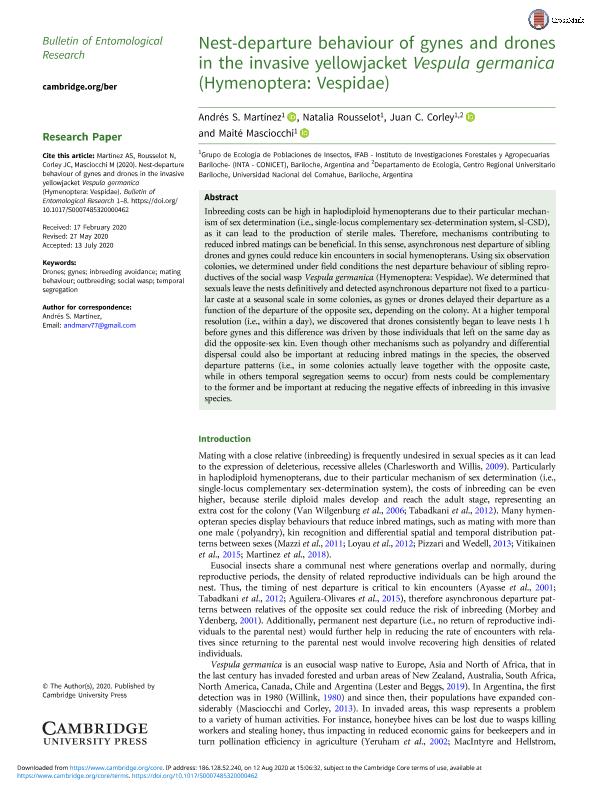Mostrar el registro sencillo del ítem
dc.contributor.author
Martinez Von Ellrichshausen, Andres Santiago

dc.contributor.author
Rousselot, Natalia
dc.contributor.author
Corley, Juan Carlos

dc.contributor.author
Masciocchi, Maité

dc.date.available
2020-10-21T20:51:35Z
dc.date.issued
2020-08
dc.identifier.citation
Martinez Von Ellrichshausen, Andres Santiago; Rousselot, Natalia; Corley, Juan Carlos; Masciocchi, Maité; Nest-departure behaviour of gynes and drones in the invasive yellowjacket Vespula germanica (Hymenoptera: Vespidae); Cambridge University Press; Bulletin of Entomological Research; 8-2020; 1-8
dc.identifier.issn
0007-4853
dc.identifier.uri
http://hdl.handle.net/11336/116291
dc.description.abstract
Inbreeding costs can be high in haplodiploid hymenopterans due to their particular mechanism of sex determination (i.e., single-locus complementary sex-determination system, sl-CSD), as it can lead to the production of sterile males. Therefore, mechanisms contributing to reduced inbred matings can be beneficial. In this sense, asynchronous nest departure of sibling drones and gynes could reduce kin encounters in social hymenopterans. Using six observation colonies, we determined under field conditions the nest departure behaviour of sibling reproductives of the social wasp Vespula germanica (Hymenoptera: Vespidae). We determined that sexuals leave the nests definitively and detected asynchronous departure not fixed to a particular caste at a seasonal scale in some colonies, as gynes or drones delayed their departure as a function of the departure of the opposite sex, depending on the colony. At a higher temporal resolution (i.e., within a day), we discovered that drones consistently began to leave nests 1 h before gynes and this difference was driven by those individuals that left on the same day as did the opposite-sex kin. Even though other mechanisms such as polyandry and differential dispersal could also be important at reducing inbred matings in the species, the observed departure patterns (i.e., in some colonies actually leave together with the opposite caste, while in others temporal segregation seems to occur) from nests could be complementary to the former and be important at reducing the negative effects of inbreeding in this invasive species.
dc.format
application/pdf
dc.language.iso
eng
dc.publisher
Cambridge University Press

dc.rights
info:eu-repo/semantics/openAccess
dc.rights.uri
https://creativecommons.org/licenses/by-nc-sa/2.5/ar/
dc.subject
DRONE
dc.subject
GYNE
dc.subject
INBREEDING AVOIDANCE
dc.subject
MATING BEHAVIOR
dc.subject
OUTBREEDING
dc.subject
SOCIAL WASP
dc.subject
TEMPORAL SEGREGATION
dc.subject.classification
Ecología

dc.subject.classification
Ciencias Biológicas

dc.subject.classification
CIENCIAS NATURALES Y EXACTAS

dc.title
Nest-departure behaviour of gynes and drones in the invasive yellowjacket Vespula germanica (Hymenoptera: Vespidae)
dc.type
info:eu-repo/semantics/article
dc.type
info:ar-repo/semantics/artículo
dc.type
info:eu-repo/semantics/publishedVersion
dc.date.updated
2020-09-03T16:52:14Z
dc.journal.pagination
1-8
dc.journal.pais
Reino Unido

dc.journal.ciudad
Cambridge
dc.description.fil
Fil: Martinez Von Ellrichshausen, Andres Santiago. Instituto Nacional de Tecnología Agropecuaria. Centro Regional Patagonia Norte. Estación Experimental Agropecuaria San Carlos de Bariloche. Instituto de Investigaciones Forestales y Agropecuarias Bariloche. - Consejo Nacional de Investigaciones Científicas y Técnicas. Centro Científico Tecnológico Conicet - Patagonia Norte. Instituto de Investigaciones Forestales y Agropecuarias Bariloche; Argentina
dc.description.fil
Fil: Rousselot, Natalia. Instituto Nacional de Tecnología Agropecuaria. Centro Regional Patagonia Norte. Estación Experimental Agropecuaria San Carlos de Bariloche. Instituto de Investigaciones Forestales y Agropecuarias Bariloche. - Consejo Nacional de Investigaciones Científicas y Técnicas. Centro Científico Tecnológico Conicet - Patagonia Norte. Instituto de Investigaciones Forestales y Agropecuarias Bariloche; Argentina
dc.description.fil
Fil: Corley, Juan Carlos. Instituto Nacional de Tecnología Agropecuaria. Centro Regional Patagonia Norte. Estación Experimental Agropecuaria San Carlos de Bariloche. Instituto de Investigaciones Forestales y Agropecuarias Bariloche. - Consejo Nacional de Investigaciones Científicas y Técnicas. Centro Científico Tecnológico Conicet - Patagonia Norte. Instituto de Investigaciones Forestales y Agropecuarias Bariloche; Argentina
dc.description.fil
Fil: Masciocchi, Maité. Instituto Nacional de Tecnología Agropecuaria. Centro Regional Patagonia Norte. Estación Experimental Agropecuaria San Carlos de Bariloche. Instituto de Investigaciones Forestales y Agropecuarias Bariloche. - Consejo Nacional de Investigaciones Científicas y Técnicas. Centro Científico Tecnológico Conicet - Patagonia Norte. Instituto de Investigaciones Forestales y Agropecuarias Bariloche; Argentina
dc.journal.title
Bulletin of Entomological Research

dc.relation.alternativeid
info:eu-repo/semantics/altIdentifier/url/https://www.cambridge.org/core/product/identifier/S0007485320000462/type/journal_article
dc.relation.alternativeid
info:eu-repo/semantics/altIdentifier/doi/http://dx.doi.org/10.1017/S0007485320000462
Archivos asociados
